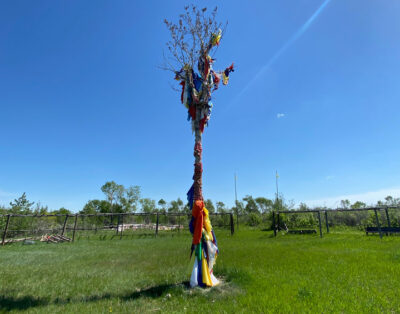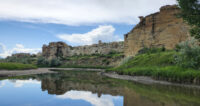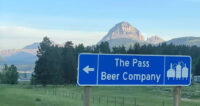Blood Tribe pays tribute to residential school victims, demands gov’t action
By Herald on June 4, 2021.
 The sacred Sundance pole is adorned with 215 orange tobacco ties prayer sticks gathered and placed during a memorial event this week near Standoff for the Kamloops Residential School victims. - Photo Courtesy of Elder Keith Chiefmoon
The sacred Sundance pole is adorned with 215 orange tobacco ties prayer sticks gathered and placed during a memorial event this week near Standoff for the Kamloops Residential School victims. - Photo Courtesy of Elder Keith ChiefmoonTim Kalinowski – Lethbridge Herald
The Blood Tribe is responding to revelations about the remains of 215 Indigenous children discovered in unmarked graves at the site of the former Kamloops Residential School with calls for acknowledgement of the colonial legacy of residential schools and the endemic problems this discriminatory system continues to perpetuate on Indigenous peoples to this day.
“Our people, Kainai, had experiences at five different residential schools, four of which were located on the Blood Reserve,” states a letter released to public signed by all the chief and council of the Blood Tribe. “St. Joseph’s Industrial School (Dunbow), the first Catholic residential school in Standoff, the first Anglican New School in Old Agency, St. Paul’s Anglican Residential School, and Immaculate Conception St. Mary’s Catholic residential school. In addition, it is necessary to include the experiences of our people in the Blood Indian Hospital.
“Today, we all continue the work to overcome what happened to us and to our ancestors,” it goes on to say. “Unfortunately, many of the children who reached adulthood could not endure the traumatic effects and found their own ways to silently cope. Many found ways of unhealthy coping led to problems beyond the reach of their stolen childhoods because the trauma was much more than they could bear. When our ancestors made treaty with the British Crown, the intent of including education was to benefit Blood Tribe/Kainai members and not the inadequate education and trauma brought about by the residential school system. This ‘education system’ is now attributed to our current Opioids crisis from the intergenerational trauma. Although words of condolence and acts of kindness are appreciated, now is the time to seek tangible outcomes from the governments of Canada and Alberta on how they can put their words into action.”
The letter goes on to demand the Province of Alberta fully include Indigenous experiences and history in its K-12 curriculum, demands provincial legislation to protect Indigenous languages, and seeks a strong commitment from the Canadian government to work on the pressing issues facing First Nations across the country.
“It is of utmost importance that we all move forward in order for the innocent souls of the 215 children to finally be at peace along with the over 100 souls of the children of Kainai who suffered a similar fate,” the letter reads.
Blood Tribe councillor Martin Heavy Head reiterated these local calls to action when he spoke to The Herald on behalf of council on Friday. He emphasized the need for the federal government to take action on Indigenous poverty, crumbling infrastructure on reserves, better education and better healthcare.
“If you really want reconciliation that’s what needs to happen,” he said.
“We need to eradicate poverty and all the social issues that are rampant on Indian reserves in Canada.”
Reflecting on the legacy of residential schools, Heavy Head said the discovery of 215 dead children in Kamloops has brought sadness, anger and bad memories for many on the reserve this past week.
“I am a third generation residential school survivor,” Heavy Head explained. “My grandfather went to Dunbow Industrial School up around Calgary. My dad went to St. Mary’s Residential School. And I went to St. Mary’s Residential School. In the history of Blood reserve there were four residential schools, and none of them had a very good history. We don’t remember our residential school years fondly.
“I think at every residential school they have found bodies,” he added.
Elder Keith Chiefmoon held a special ceremony at Standoff on Thursday to help deal with his people’s own trauma and grief. He hoped by doing so he would help lay the spirits of the 215 children to rest, and help soothe the ghosts which still haunt many on the Blood Tribe from their own families’ residential school experiences.
“For each victim we honoured them with a beat of the big drum,” he explained. “The big drum comes from thunder; so the big boom we hear symbolically represents the thunder spirit. For each we had 215 beats, and we put the tobacco pouch acknowledging we don’t know how they died because of the way records were kept (at the Kamloops residential school).”
Chiefmoon said he prayed to the Creator to help his people because they didn’t know what to do about these dead children in Kamloops from “their relatives across the mountains.” He prayed for the children to continue on their journey into the next world and find rest.
“We paid tribute to the 215 victims, and I guess from our perspective we are just disappointed in the leadership we have (in Alberta and Canada),” he said. “For us at the Kainai community those types of things are unacceptable. I can’t begin to imagine taking the life of a helpless young child.
“I guess all across the world Canada is the only place you are allowed to kill Indigenous people without any consequences.”
Follow @TimKalHerald on Twitter
19-18




